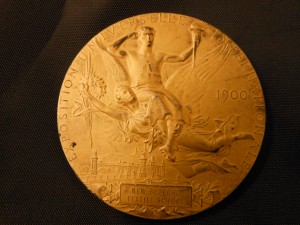 The Paris Exposition Universelle Internationale of 1900 was one of a series of world’s fairs held up to the end of the 19th century. Surrounding the Eiffel Tower in Paris, France, with 530 acres of gardens, buildings, walks and waterways, the fair was held from April 15th to November 12th, 1900. Its purpose was to celebrate the achievements of the past century and to accelerate development into the next. The first international fair of this sort was held in Paris in 1855. However, the 1900 fair would be the last major international fair. The cost to put it on exceeded its revenue, and investors lost considerable amounts of money. The assassination of American President William McKinley in November of 1900 also precipitated its early closure. Each country that participated created exhibits showing their achievements in education, medicine, social welfare, science, mining, manufacturing and the arts. A visitor’s program including a complete list of exhibitors in the America pavilion can be found online at http://archive.org/details/catalogueexhibi01unkngoog
The Paris Exposition Universelle Internationale of 1900 was one of a series of world’s fairs held up to the end of the 19th century. Surrounding the Eiffel Tower in Paris, France, with 530 acres of gardens, buildings, walks and waterways, the fair was held from April 15th to November 12th, 1900. Its purpose was to celebrate the achievements of the past century and to accelerate development into the next. The first international fair of this sort was held in Paris in 1855. However, the 1900 fair would be the last major international fair. The cost to put it on exceeded its revenue, and investors lost considerable amounts of money. The assassination of American President William McKinley in November of 1900 also precipitated its early closure. Each country that participated created exhibits showing their achievements in education, medicine, social welfare, science, mining, manufacturing and the arts. A visitor’s program including a complete list of exhibitors in the America pavilion can be found online at http://archive.org/details/catalogueexhibi01unkngoog
 The New Bedford Textile School is listed on page 443 of this program as an exhibitor under the classification of “Apprenticeship: Protection of Child Labor” in the Social Economy, Hygiene, and Public Charities Group. For many years, the UMD Archives and Special Collections have held two medallions that were made to commemorate the Exposition. One is bronze and the other is gold-plated bronze (at left). Both have “New Bedford Textile School” stamped in a rectangle at the bottom of the front of the medallion. My assumption is that the stamp has something to do with the fact that they were exhibitors. For such an important international event, it is curious that there is no mention of the exposition or the medallions in the records of the trustees of the New Bedford Textile School.
The New Bedford Textile School is listed on page 443 of this program as an exhibitor under the classification of “Apprenticeship: Protection of Child Labor” in the Social Economy, Hygiene, and Public Charities Group. For many years, the UMD Archives and Special Collections have held two medallions that were made to commemorate the Exposition. One is bronze and the other is gold-plated bronze (at left). Both have “New Bedford Textile School” stamped in a rectangle at the bottom of the front of the medallion. My assumption is that the stamp has something to do with the fact that they were exhibitors. For such an important international event, it is curious that there is no mention of the exposition or the medallions in the records of the trustees of the New Bedford Textile School.
As an interesting aside, Campbell Soups won a prestigious award at the exposition for its innovation in condensed soup. The Campbell Soup labels have displayed this medallion ever since! Other innovations introduced at the exposition were the escalator, ferris wheels, diesel engines and nesting Russian dolls.
A number of catalogues and other publications with illustrations of the exhibits, buildings and grounds have been digitized and are available at the Internet Archive at the following links:
http://archive.org/details/lexpositiondusi00quan
http://archive.org/details/lesprincipauxpal00ragu
Thanks to wikipedia.org, Archives.org, and various medallion sellers on the web for content used in this post.

